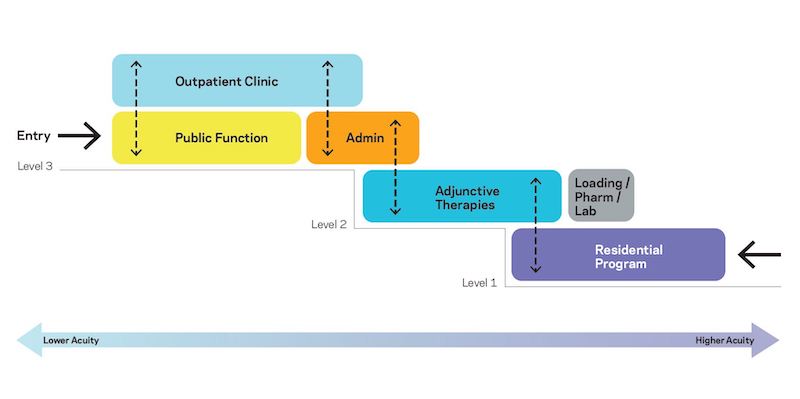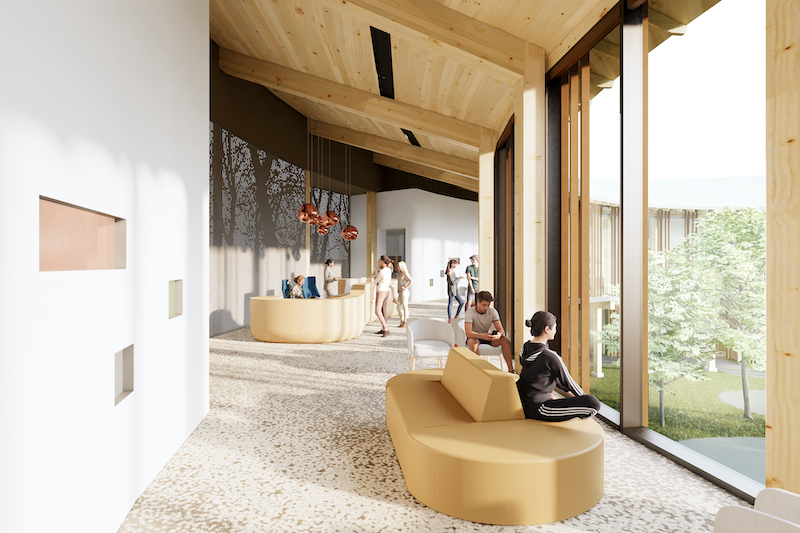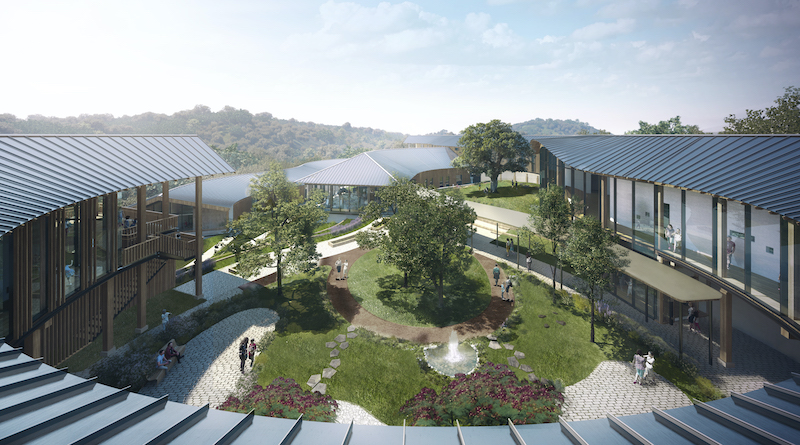A survey of 1,313 Americans ages 18 or older, which KFF Tracking conducted last July, found that more than half of those polled, 53%, reported their mental health had been negatively impacted by the coronavirus pandemic. Even before the virus started spreading, an estimated 26% of Americans suffered from diagnosable mental disorder in a given year, according to the National Institute of Mental Health Disorders.
The demand for healthcare facilities that offer mental and behavioral health services is increasing, and presents new design and construction opportunities to AEC firms.
About a year ago, on March 10, 2020, Nationwide Children’s Hospital debuted its nine-story $159 million Big Lots Behavioral Health Pavilion in Columbus, Ohio. The pavilion, designed by NBBJ and built by Turner Construction, opened as the largest pediatric facility for this specialty in the country. It has 48 inpatient beds, a psychiatric crisis department, 10 rooms for observation stays up to 24 hours, a 12-bed stabilization unit for stays up to 72 hours, and a range of outpatient treatment.

The proposed programming for the Ohana Center for Health is devised to offer a healing environment.
NBBJ also designed the 55,600-sf Ohana Center for Health in Monterey, Calif., which recently broke ground and is scheduled to open in early 2023. The project’s construction and programming are being funded by a $105.8 million donation to the Montage Health Foundation from Roberta Bialek Elliott, the sister of billionaire investor Warren Buffett. Ms. Elliott lives in Monterey and previously served on Montage Health’s Board of Trustees, according to the Chronicle of Philanthropy.
The Building Team on the Ohana Center for Health includes South Bay Construction (GC), Integral Group (MEP), Fast + Epp (SE), Whitson Engineers (CE), and BFS Landscape Architects (landscape).
BRINGING A HUMAN TOUCH TO HEALTHCARE
Jonathan Ward, FAIA, Design Partner in NBBJ’s Los Angeles office, tells BD+C that his firm’s longstanding commitment to humanizing healthcare makes it a good fit for this trend for behavioral and mental health facilities. “Before the pandemic, most of these places weren’t very nice. Now, society is destigmatizing mental health, and here is an opportunity for people to get treatment in better settings.”
“Ohana” means “family” in Hawaiian, and this venture will include everything from an actual “Ohana House” (a kind of apartment) to early intervention, comprehensive support for young people and their families, and partnerships with an extensive collection of existing community organizations.
“We envision a warm, welcoming center on Montage Health property at Ryan Ranch,” said Dr. Steven Packer, President and CEO of Montage Health. “But we see much more than bricks and mortar—a groundbreaking hub for comprehensive, innovative solutions, with concentric circles of care emanating throughout our community.”
According to Montage Health, there is a critical shortage of psychiatrists at a time when as many as one in five children ages 9 to 17 in the U.S. may have a diagnosable psychiatric disorder.
CLT USED EXTENSIVELY

The residential hub (above) and outpatient lobby (below) accentuate how cross-laminated timber is being used throughout the facility.
 NBBJ’s design for Ohana Center for Health brings together the latest in neuroscience research—Ward says his firm consulted with the brain scientist and author Dr. John Medina—to provide a healing environment for children and teenagers, as well as for caregivers who, in this field, have an annual turnover rate that exceeds 40%.
NBBJ’s design for Ohana Center for Health brings together the latest in neuroscience research—Ward says his firm consulted with the brain scientist and author Dr. John Medina—to provide a healing environment for children and teenagers, as well as for caregivers who, in this field, have an annual turnover rate that exceeds 40%.
The design immerses the Center in what Ward calls “an intentional connection to nature,” by creating a series of large outdoor cloisters, patios, and terraced spaces. Flowing water wends through the site. Prospect and refuge spaces offer privacy and natural views. Gardens with immune-boosting plants such as lavender and rosemary offer therapy and music to patients and visitors.
The Center is designed to encourage movement, which boosts the executive function of the brain in ways said to reduce mental illness. The Center will include a gym, outdoor nature trails and other forms of outside activities.
Another humanizing aspect of the design, says Ward, is its use of cross-laminated timber (CLT). This is one of the largest healthcare projects in the country to use CLT, whose modular components can be assembled offsite. The use of this composite material helps lower the facility’s carbon footprint, and will reduce materials waste during construction.
Related Stories
| Apr 2, 2014
The new model of healthcare facility management
A growing number of healthcare organizations are moving to an integrated real estate model in an effort to better manage costs, respond to regulatory requirements, and support changes in patient care delivery.
| Apr 2, 2014
8 tips for avoiding thermal bridges in window applications
Aligning thermal breaks and applying air barriers are among the top design and installation tricks recommended by building enclosure experts.
| Mar 26, 2014
Callison launches sustainable design tool with 84 proven strategies
Hybrid ventilation, nighttime cooling, and fuel cell technology are among the dozens of sustainable design techniques profiled by Callison on its new website, Matrix.Callison.com.
Sponsored | | Mar 25, 2014
Johns Hopkins chooses SLENDERWALL for a critical medical facility reconstruction
After decades of wear, the hand-laid brick envelope of the Johns Hopkins nine-story Nelson/Harvey inpatient facility began failing. SLENDERWALL met the requirements for renovation.
| Mar 20, 2014
Common EIFS failures, and how to prevent them
Poor workmanship, impact damage, building movement, and incompatible or unsound substrate are among the major culprits of EIFS problems.
| Mar 19, 2014
How to develop a healthcare capital project using a 'true north charter'
Because healthcare projects take years to implement, developing a true north charter is essential for keeping the entire team on track and moving in the right direction.
| Mar 18, 2014
6 keys to better healthcare design
Healthcare facility planning and design experts cite six factors that Building Teams need to keep in mind on their next healthcare project.
| Mar 18, 2014
How your AEC firm can win more healthcare projects
Cutthroat competition and the vagaries of the Affordable Healthcare Act are making capital planning a more daunting task than ever. Our experts provide inside advice on how AEC firms can secure more work from hospital systems.
| Mar 13, 2014
Do you really 'always turn right'?
The first visitor center we designed was the Ernest F. Coe Visitor Center for the Everglades National Park in 1993. I remember it well for a variety of reasons, not the least of which was the ongoing dialogue we had with our retail consultant. He insisted that the gift shop be located on the right as one exited the visitor center because people “always turn right.”
| Mar 12, 2014
14 new ideas for doors and door hardware
From a high-tech classroom lockdown system to an impact-resistant wide-stile door line, BD+C editors present a collection of door and door hardware innovations.















